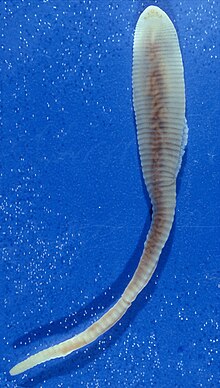Pentastomid
| Pentastomida Temporal range: Cambrian Stage 3–Recent |
|
|---|---|
 |
|
| Adult female Linguatula serrata | |
| Scientific classification | |
| Kingdom: | Animalia |
| Phylum: | Arthropoda |
| Subphylum: | Crustacea |
| Class: | Maxillopoda |
| Subclass: |
Pentastomida Diesing, 1836 |
| Orders | |
Pentastomida are an enigmatic group of parasitic crustaceans commonly known as tongue worms due to the resemblance of the species of the genus Linguatula to a vertebrate tongue.
There are about 130 extant species of pentastomids; all are obligate parasites with correspondingly degenerate anatomy. Adult tongue worms vary from about 1 to 14 centimetres (0.4 to 5.5 in) in length, and parasitise the respiratory tracts of vertebrates. They have five anterior appendages. One is the mouth; the others are two pairs of hooks which they use to attach to the host. This arrangement led to their scientific name, meaning "five openings", but although the appendages are similar in some species, only one is a mouth.
Alternative names for the Pentastomida include Pentastoma (strictly a genus name), Linguatulida, and Acanthotheca.
Historically significant accounts of tongue worm biology and systematics include early work by Josef Aloys Frölich,Alexander von Humboldt,Karl Asmund Rudolphi,Karl Moriz Diesing and Rudolph Leuckart.
Other important summaries have been published by Louis Westenra Sambon,Richard Heymons and John Riley, and a review of their evolutionary relationships with a bibliography up to 1969 was published by J. T. Self.
Pentastomids are worm-like animals ranging from 2 to 13 centimetres (0.79 to 5.12 in) in length. The anterior end of the body bears five protuberances, four of which are clawed legs, while the fifth bears the mouth. The body is segmented and covered in a chitinous cuticle. The digestive tract is simple and tubular, since the animal feeds entirely on blood, although the mouth is somewhat modified as a muscular pump.
The nervous system is similar to that of other arthropods, including a ventral nerve cord with ganglia in each segment. Although the body contains a haemocoel, there are no circulatory, respiratory, or excretory organs.
...
Wikipedia
